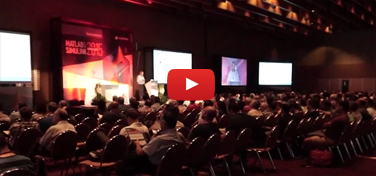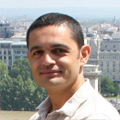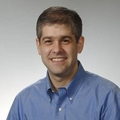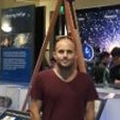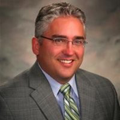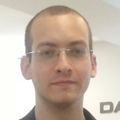
[ מרצים בכנס ]
עודד לבנטר
מנכ"ל, סיסטמטיקס
רועי פן
מהנדס יישומי עיבוד תמונה, ראיה ממוחשבת ולמידה עמוקה – סיסטמטיקס
רוני פאר
מנהל הפעילות הטכנית,
סיסטמטיקס
Kirthi Devleker
Sr. Product Manager – Machine Learning and Signal Processing, MathWorks
Bruce Tannenbaum
Technical Marketing Manager, MathWorks
לורן סממה
מהנדסת יישומי Data Science, סיסטמטיקס
איתמר אנגלמן
מהנדס יישומי אוטומציה ובקרה, סיסטמטיקס
שלומי שרגא
מהנדס יישומי עיבוד אות ותקשורת, סיסטמטיקס
אריאל רובננקו
צוות AOCS, חברת SpaceIL
אביאסף מוזס
מהנדס יישומי אווירונאוטיקה ובקרה, סיסטמטיקס
יואב תמרי
ישקר
Brian von Gunten
Speedgoat
ינון נוסבאום
מהנדס יישומי עיבוד אות ותקשורת, סיסטמטיקס
[ סדר יום ]
הערה:
חלק מההרצאות יועברו בשפה האנגלית.
ההשתתפות הינה ללא תשלום, אך מחייבת הרשמה מראש.
| 08:30 | התכנסות ורישום |
| 9:00 | דברי פתיחה עודד לבנטר, מנכ"ל סיסטמטיקס |
| 9:15 | Keynote: Beyond the “I” in AI – Insight, Implementation, Integration Bruce Tannenbaum, Technical Marketing Manager, MathWorks |
| 9:45 | Demystifying deep learning: a practical approach in MATLAB רועי פן, מהנדס יישומי עיבוד תמונה, ראיה ממוחשבת ולמידה עמוקה, סיסטמטיקס |
| 10:15 | סיפור לקוח – חברת EarlySense MATLAB to support the life cycle of medical devices: From idea to product line Guy Meger, CTO and GM, EarlySense |
| 10:30 | Becoming a Data-Centric Engineering Team לורן סממה, מהנדסת יישומי Data Science, סיסטמטיקס |
| 11:00 | הפסקת קפה |
| 11:30 | תכנון גמיש בגישת (Model-Based Design (MBD רוני פאר, מנהל קבוצת AEG, סיסטמטיקס |
| 11:55 | "בראשית" – היה MATLAB אריאל רובננקו, צוות AOCS, חברת SpaceIL |
| 12:15 | שימוש בגישת MBD לתכנון מערכת אוטונומית אביאסף מוזס, מהנדס יישומי אווירונאוטיקה ובקרה, סיסטמטיקס |
| 13:00 | ארוחת צהריים |
| 14:00 | חלוקה ל-3 מסלולים מקצועיים
מסלול עיבוד וידאו ותמונה |
| 16:30 | הגרלה בכל אחד מהמסלולים השונים |
13:00-16:00 – חלוקה ל- 3 מסלולים מקצועיים מקבילים:
מסלול עיבוד וידאו ותמונה
| 14:00 | תהליך הפיתוח: From Algorithm to Implementation in the IPCV world Bruce Tannenbaum, MathWorks |
| 14:30 | טרנד מוביל: למידה עמוקה ליישומי עיבוד תמונה רועי פן, מהנדס יישומי עיבוד תמונה, ראיה ממוחשבת ולמידה עמוקה – סיסטמטיקס |
| 15:00 |
מה חדש, טיפים וטריקים בעולם עיבוד הוידאו והתמונה |
| 15:30 | סיפור משתמש – גילוי וסיווג אובייקטים בחברת ישקר יואב תמרי, מהנדס חשמל, מחלקת טכנולוגיות מיוחדות בחטיבת הייצור, ישקר |
| 15:45 | פתרונות nVIDIA בעולם של MATLAB Ofir Zamir, Director Solutions Architecture חברת nVIDIA ישראל |
| 16:05 | Deploying Deep Neural Networks to Embedded GPUs and CPUs לורן סממה, סיסטמטיקס |
| 16:30 | הגרלה – רכיב Jetson TX2 של nVIDIA |
[ הרצאות ומסלולים מקצועיים ]
מסלול עיבוד וידאו ותמונה
From Algorithm to Implementation – Workflow for Image Processing and Computer Vision
From Algorithm to Implementation – Workflow for Image Processing and Computer Vision
Bruce Tannenbaum, MathWorks
Image processing and computer vision are enabling technologies for the development of many smart systems today, including self-driving cars, augmented reality, and autonomous robotics. While each situation is unique, the design workflow is consistent: algorithm development, iterative design exploration, and evaluation of implementation tradeoffs. In this talk, we will discuss how MATLAB® and Simulink® can be used to address common workflow challenges along the way to embedded implementation.
למידה עמוקה ליישומי עיבוד תמונה
למידה עמוקה ליישומי עיבוד תמונה
רועי פן, מהנדס יישומי עיבוד תמונה, ראיה ממוחשבת ולמידה עמוקה, סיסטמטיקס
בהמשך לסקירה שניתנה בהרצאת המליאה, נצלול כעת לעומק של תחום הלמידה העמוקה, עם דוגמאות ממוקדות לעולם עיבוד התמונה והראיה הממוחשבת. הרצאה טכנית זו תכלול מספר דוגמאות שימושיות ומתקדמות אשר ימחישו כמה קל לבצע למידה עמוקה בסביבת MATLAB, ולאילו תוצאות מעולות ניתן להגיע באמצעות כך, עבור בעיות מורכבות במיוחד.
מה חדש, טיפים וטריקים בעולם עיבוד הוידאו והתמונה
מה חדש, טיפים וטריקים בעולם עיבוד הוידאו והתמונה
רועי פן, מהנדס יישומי עיבוד תמונה, ראיה ממוחשבת ולמידה עמוקה – סיסטמטיקס
בכל שנה מוציאה חברת MathWorks שתי גרסאות תוכנה, הכוללות עדכונים, תיקונים ויכולות חדשות בכלי הפיתוח השונים. תחום עיבוד הוידאו והתמונה הוא אחד התחומים שמתפתחים בצורה הכי מהירה, עם Support Packages שמשוחררים בין הגרסאות, תמיכה בכל היכולות החדשות בתחומי הלמידה העמוקה, ממשקים פתוחים למערכות וכלים נוספים ועוד.
מעבר לכלים החדשים (Deep Learning Toolbox, Reinforcement Learning), והתמיכה ביצירת קוד בצורה מקבילית למגוון רחב של מעבדים, יש יכולות מובנות בסביבת MATLAB שמאפשרות הרצה מהירה יותר, שימוש ב-Apps להאצת תהליך הפיתוח, וכן פונקציות חדשות שמטרתן להקל על תהליך הפיתוח.
בהרצאה זו נסקור חלק מיכולות אלו ונדגים את העיקריות שבהן.
סיפור משתמש - גילוי וסיווג אובייקטים בחברת ישקר
סיפור משתמש – גילוי וסיווג אובייקטים בחברת ישקר
יואב תמרי, מהנדס חשמל, מחלקת טכנולוגיות מיוחדות בחטיבת הייצור, ישקר
ישקר הינה חברה גלובלית שמרכזה בתפן שבגליל. החברה נמנית על אחת מ-3 קבוצות החברות הגדולות והמצליחות בעולם בתחום ייצור ושיווק כלים ופתרונות מתקדמים לעיבוד שבבי וידועה כמובילה ומחויבת לחדשנות של פיתוח טכנולוגיות ומוצרים חדשים.
בהרצאה יתוארו צעדי הלימוד העצמי של תחום ה-Deep Learning בחברה לצורך ניתוח תמונות בסביבת MATLAB. הלימוד נעשה תוך שימוש בפונקציות גילוי מבוססות RCNN ו-Faster RCNN, במטרה לגלות אובייקטים בתמונות ולסווג אותם.
Deploying Deep Neural Networks to Embedded GPUs and CPUs
Deploying Deep Neural Networks to Embedded GPUs and CPUs
לורן סממה, סיסטמטיקס
Designing and deploying deep learning and computer vision applications to embedded GPU and CPU platforms like NVIDIA® Jetson AGX Xavier™ and DRIVE AGX is challenging because of resource constraints inherent in embedded devices. A MATLAB® based workflow facilitates the design of these applications, and automatically generated C/C++ or CUDA® code can be deployed to achieve up to 2X faster inference than other deep learning frameworks.
This talk walks you through the workflow. Starting with algorithm design, you can employ deep neural networks augmented with traditional computer vision techniques which can be tested and verified within MATLAB. Bring live sensor data from peripheral devices on your Jetson/DRIVE platforms to MATLAB running on your host machine for visualization and analysis. Train your deep neural networks using GPUs and CPUs on the desktop, cluster, or cloud. Finally, GPU Coder™ and MATLAB Coder™ generate portable and optimized CUDA and/or C/C++ code from the MATLAB algorithm, which is then cross-compiled and deployed to Jetson or DRIVE, ARM®, and Intel® based platforms.
GPU computing became the leading architecture for HPC and AI - Nvidia
Ofir Zamir, Director Solutions Architecture
GPU computing became the leading architecture for HPC and AI. Nvidia will present the latest innovations and developer tools including end to end AI platform from data center to edge
הרצאות מליאה
Beyond the “I” in AI - Insight. Implementation. Integration
Beyond the “I” in AI – Insight. Implementation. Integration.
Bruce Tannenbaum, Technical Marketing Manager, MathWorks
AI, or artificial intelligence, is transforming the products we build and the way we do business. It also presents new challenges for those who need to build AI into their systems. Creating an “AI-driven” system requires more than developing intelligent algorithms. It also requires:
- Insights from domain experts to generate the tests, models, and scenarios required to build confidence in the overall system
- Implementation details including data preparation, compute-platform selection, modelling and simulation, and automatic code generation
- Integration into the final engineered system
Join us Bruce Tannenbaum demonstrates how engineers and scientists are using MATLAB® and Simulink® to successfully design and incorporate AI into the next generation of smart, connected systems.
Demystifying Deep Learning: A Practical Approach in MATLAB
Demystifying Deep Learning: A Practical Approach in MATLAB
רועי פן, מהנדס יישומי עיבוד תמונה, ראיה ממוחשבת ולמידה עמוקה, סיסטמטיקס
Deep learning can achieve state-of-the-art accuracy in many humanlike tasks such as naming objects in a scene or recognizing optimal paths in an environment.
The main tasks are to assemble large data sets, create a neural network, to train, visualize and evaluate different models, using specialized hardware – often requiring unique programming knowledge. These tasks are frequently even more challenging because of the complex theory behind them.
In this lecture, we’ll demonstrate new MATLAB features that eliminate the low-level programming and that make it easy to:
- Manage extremely large sets of images
- Visualize networks and gain insight into the black box nature of deep networks
- Perform classification and pixel-level semantic segmentation on images
- Import training data sets from networks such as GoogLeNet and ResNet
- Import and use pre-trained models from TensorFlow and Caffe
- Speed up network training with parallel computing on a cluster
- Automate manual effort required to label ground truth
- Automatically convert a model to CUDA to run on GPUs
Becoming a Data-Centric Engineering Team
Becoming a Data-Centric Engineering Team
לורן סממה, מהנדסת יישומי Data Science, סיסטמטיקס
Engineering teams have more data available to them than ever before. Data from tests, operations, production, and other sources present opportunities for data-based design decisions and new data-based products and services. But many teams struggle to come up with a consistent set of tools and processes for extracting value from this data.
This talk presents a variety of new MATLAB® features for accessing, organizing, and analyzing data, with a special focus on the MATLAB datastore framework for working with large collections of files and MATLAB datatypes for organizing and preprocessing sensor data. See how these tools enable engineering teams to grow from ad-hoc data analysis to building centralized tools for organization-wide use, laying a foundation for production apps and analytics.
תכנון גמיש בגישת (Model-Based Design (MBD
תכנון גמיש בגישת (Model-Based Design (MBD
רוני פאר, מנהל קבוצת AEG, סיסטמטיקס
"בראשית" – היה MATLAB
"בראשית" – היה MATLAB
אריאל רובננקו, צוות AOCS, SpaceIL
החללית "בראשית" הינה החללית הישראלית הראשונה שהגיעה לירח, בפרויקט ששבה את לב כל האומה.
אריאל רובננקו, מצוות AOCS של הפרויקט, ישוחח על כיצד פותחה תוכנת הטייס האוטומטי של "בראשית" באמצעות כלי הפיתוח של MATLAB ו-Simulink. בפרויקט, שארך מספר שנים, נעשה שימוש נרחב ב-MATLAB – החל משלב האנליזות והסימולציות של התכן הראשוני ועד לשימוש המבצעי בחדר הבקרה – לאורך שבעת השבועות של המשימה הסופית.
אריאל ישתף כיצד הוקמה הסימולציה הדינמית המלאה, על המעבר לשלב המימוש – באמצעות יצירת קוד אוטומטי, על האינטראקציה עם קבוצות הפיתוח הנוספות של הפרויקט וכיצד בוצעו בדיקות הוולידציה האינטנסיביות של התוכנה.
סיפור לקוח – EarlySense
MATLAB to support a full life cycle of a medical device: From idea to a product line
Guy Meger, CTO and GM, EarlySense
Traditional development of a Signal-Processing-based technologies included very few stages and few teams: algorithm developers to develop solutions and signal processing Software developers to implement the solutions.
The communication challenges between the teams and different sets of skills have always been a key factor to meet both performances and time.
The MATLAB platform allowed EarlySense to make this process redundant, by basing the entire development cycle on MATLAB and relying on MATLAB tools for the deployment process on the different HW targets.
Over time, we changed HW architecture using different processors, running the same code written in MATLAB and adapted to different hardware platforms, such as x86, ARM-Cortex etc. Porting the core technology from one platform to a different (even cellular) was always very smooth.
In the presentation, Guy Meger will describe how the product life cycle was supported with different MATLAB tools when different needs were raised.
שימוש בגישת MBD לתכנון מערכת אוטונומית
שימוש בגישת MBD לתכנון מערכת אוטונומית
אסף מוזס, מהנדס יישומי אווירונאוטיקה ובקרה, סיסטמטיקס
מערכת אוטונומית הינה מערכת אשר מתפקדת בצורה עצמאית לחלוטין או בצורה מפוקחת (supervised), ופועלת בתנאי אי ודאות, בסביבה לא ידועה ודינמית, ובמקרים רבים גם לא צפויה מראש.
מערכות אוטונומיות עשויות לצבור ידע חדש או להתאים עצמן לסביבה המשתנה בכדי להשלים את ייעודן. בכדי לעמוד במשימתן, מערכות אוטונומיות יכולות לרכוש מידע מהסביבה בה הן נמצאות, לנוע בצורה עצמאית בסביבתן (וירטואלית או מציאותית כמובן), להימנע ממצבים מסוכנים, ולפעול למשך תקופה ארוכה ללא התערבות אדם.
גישת Model-Based Design של חברת MathWorks, המבוססת על כלי MATLAB & Simulink, כוללת יכולות רבות המוכוונות לפיתוח של מערכות אוטונומיות, ומאפשרת סימולציה, תכנון ובחינה של מערכות אוטונומיות בצורה פשוטה. גישה זו מאפשרת לחסוך זמן רב בהליך הפיתוח והגעה לאב-טיפוס בצורה יעילה ומהירה.
בהרצאה זו נסקור מספר יכולות אשר מאפשרות להפוך את המערכת המתוכננת למערכת אוטונומית המקבלת החלטות באופן עצמאי. נראה כיצד ניתן לבנות פלטפורמה המשמשת כבסיס של סביבת הפיתוח, כיצד מאפשרים למערכת יכולות של תפיסה והבנה של הסובב אותה (Perception), כיצד ממדלים ומסמלצים חיישנים ומבצעים היתוך המידע המתקבל מהם, אופן התכנון והבקרה של מסלול תנועת המערכת ולבסוף כיצד ניתן לממשק את המערכת עם סביבות חיצוניות להשלמת התמונה המלאה.
מסלול סימולציה מערכתית ומערכות בקרה
מידול מערכתי וסימולציה של Aileron בגישת Model-Based Design
מידול מערכתי וסימולציה של Aileron בגישת Model-Based Design
אסף מוזס, מהנדס יישומי אווירונאוטיקה ובקרה, סיסטמטיקס
כלי הפיתוח של MathWorks מאפשרים מידול של מערכות פיסיקליות בתחומים רבים ומגוונים. סימולציה של המודלים הפיסיקליים מאפשרת בחינה מהירה של ביצועי המערכת, הרבה לפני בניית אב-טיפוס.
בהרצאה זו נראה כיצד מהנדסים, מדענים וחוקרים משתמשים בכלי סימולציה במטרה לקבל הבנה מעמיקה יותר בכל הנוגע למערכות מולטי-דיסציפלינריות מורכבות.
באמצעות דוגמא של מאזנת (Aileron) נסקור בצורה מעמיקה את תהליך הפיתוח של מערכת מולטי-דיסציפלינארית, תהליך הכולל מידול, סימולציה, אופטימיזציה ובקרה: ייבוא נתונים מתוכנות תיב”ם (3D CAD) לסביבת העבודה של Simulink, החייאת המודל והפעלתו, תכן חוגי הבקרה, יישום של אלגוריתמים מעולם הרובוטיקה ועוד.
מה חדש, טיפים וטריקים בתכנון מערכות בקרה
מה חדש, טיפים וטריקים בתכנון מערכות בקרה
איתמר אנגלמן, מהנדס יישומי אוטומציה ובקרה, סיסטמטיקס
בכל שנה מוציאה חברת MathWorks שתי גרסאות תוכנה, הכוללות עדכונים, תיקונים ויכולות חדשות בכלי הפיתוח השונים. תחום תכנון המערכת ומערכות הבקרה חווה בשנתיים האחרונות מגוון רחב של כלים ויכולות חדשות: תכנון מערכות בעזרת System Composer, Predictive Maintenance וכמובן Reinforcement Learning. בנוסף לכך, תמיכה בחומרות מסוגים שונים – גם לטובת פיתוח (ארדואינו, Parrot, PixHawk) וגם לטובת יישום סופי (TI, ST, ARM ועוד).
מעבר לכך, יש יכולות מובנות בסביבת MATLAB שמאפשרות הרצה מהירה יותר, שימוש ב-Apps להאצת תהליך הפיתוח, אופטימיזציה של הליך התכנון ומציאת פתרון בצורה אוטומטית וכן פונקציות חדשות שמטרתן להקל על תהליך הפיתוח.
בהרצאה זו נסקור חלק מיכולות אלו ונדגים את העיקריות שבהן.
יישום מערכות בקרה על גבי רכיבי PLC של Beckhoff Automation
יישום מערכות בקרה על גבי רכיבי PLC של Beckhoff Automation
שני קפלן, חברת Beckhoff Automation
Hardware in the Loop? We have a SpeedGoat for that
Hardware in the Loop? We have a SpeedGoat for that!
Bringing Vision Sensor into Simulink Real-Time on Speedgoat Hardware for Simulation and Testing:
Brian Von Gunten, Senior Developer, Speedgoat
This presentation will begin with a quick introduction to the Speedgoat hardware ecosystem, Simulink Real-Time and HDL Coder, including a system level overview of the machine architecture and a few words on the relevant user workflows in Simulink. Next, a new Speedgoat product for HDMI/SDI vision data I/O for a Simulink-Programmable FPGA Module will be introduced. Several important Speedgoat infrastructure components for constructing vision data pipelines that enable the scaling of vision algorithms between the Real-Time Target Machine’s CPU domain and FPGA Modules as well as between multiple FPGA Modules will be explained. Finally, the next generation of vision hardware will be briefly introduced, with a few words on the relevant strategies being employed for new camera and other vision related I/O interfaces.
מסלול עיבוד אות ותקשורת
MATLAB: From Concept to Embedded Code
MATLAB: From Concept to Embedded Code
שלומי שרגא, מהנדס יישומי עיבוד אות ותקשורת, סיסטמטיקס
Leveraging Deep Learning for Signal Processing Applications
Leveraging Deep Learning for Signal Processing Applications
Kirthi Devleker, MathWorks
This session focuses on the new approaches / architectures for performing Deep Learning on signals in MATLAB using latest features. The goal of the session is to showcase how easy it is to build a deep learning predictive model on signal data and then use the model to make live predictions and we will do so with real examples. The first example covers an approach to build a Modulation Detection model with the help of realistic simulated data using Deep Networks and then use the model to make live predictions on real wireless signals captured using Software Defined radio connected to MATLAB. Topics covered include how to generate data with impairments, process the I-Q samples, create and build a deep network model from scratch. In the second example we will look into how one can leverage Invariant Scattering Convolutional Networks and Deep Networks like LSTMs to build predictive models on signals. We will show how you can use these techniques to build a classifier that can identify the genre of a music sample and we will make predictions on new music samples. The techniques covered in this session can be applicable to any signals / timeseries data.
מה חדש, טיפים וטריקים בעולם עיבוד האות והתקשורת
מה חדש, טיפים וטריקים בעולם עיבוד האות והתקשורת
ינון נוסבאום, מהנדס יישומי עיבוד אות ותקשורת, סיסטמטיקס
בכל שנה מוציאה חברת MathWorks שתי גרסאות תוכנה, הכוללות עדכונים, תיקונים ויכולות חדשות בכלי הפיתוח השונים. תחום עיבוד האות והתקשורת חווה בשנתיים האחרונות מגוון רחב מאד של כלים ויכולות חדשות: תמיכה ב-5G, פיתוח מערכות Mixed Signal ו-SerDes, Sensor Fusion and Tracking וכמובן עוד ועוד מעבדי קצה שנתמכים ליצירת קוד.
מעבר לכך, יש יכולות מובנות בסביבת MATLAB שמאפשרות הרצה מהירה יותר, שימוש ב-Apps להאצת תהליך הפיתוח, וכן פונקציות חדשות שמטרתן להקל על תהליך הפיתוח.
בהרצאה זו נסקור חלק מיכולות אלו ונדגים את העיקריות שבהן.
יישום גישת MBD בפיתוח רכיבי FPGA, ASIC ו-SoC
יישום גישת MBD בפיתוח רכיבי FPGA, ASIC ו-SoC
רון איליזרוב, מהנדס יישומי עיבוד אות ומערכות חומרה, סיסטמטיקס
The competing demands of functional innovation, aggressive schedules, and product quality have significantly strained traditional FPGA, ASIC, and SoC development workflows.
This talk shows how you can use Model-Based Design with MATLAB® and Simulink® for algorithm- and system-level design and verification, including how to:
- Verify the functionality of algorithms in the system context
- Refine algorithms with data types and architectures suitable for FPGA, ASIC, and SoC implementation
- Prototype and debug models running live on hardware connected to MATLAB or Simulink
- Generate and re-generate verified design and verification models for the hardware engineering team
- Keep the workflow connected to speed verification closure and meet functional safety requirements
[ אורחים מחברת MathWorks ]
Kirthi Devleker, Sr. Product Manager - Machine Learning and Signal Processing, MathWorks
Kirthi Devleker, Sr. Product Manager – Machine Learning and Signal Processing, MathWorks
Kirthi K. Devleker is a Senior Product Manager at MathWorks focusing on Machine Learning and Deep Learning applications for sensor data. Kirthi is responsible for overall product strategy, roadmap and marketing strategy for Signal Processing products at MathWorks. He specializes in helping the signal processing and larger data science community see the benefits of latest advanced signal processing techniques / algorithms in MATLAB to obtain insights from sensor data across multiple industry verticals such as Aero-Defense, Automotive, Medical Devices, and other industries. Kirthi has been with MathWorks for 9 years; and has a master’s in electrical engineering from San Jose State University, CA USA. Prior to joining MathWorks, Kirthi worked as a software evangelist developing sensor characterization tools in MATLAB.
Bruce Tannenbaum, Technical Marketing Manager, MathWorks
Bruce Tannenbaum, Technical Marketing Manager, MathWorks
Bruce is the manager of technical marketing for vision, AI, and IoT applications at MathWorks. His background is in image processing and computer vision system design. Earlier in his career, Bruce worked on digital cameras, inkjet MFPs, computer vision systems, and standardization efforts for MPEG-4 and JPEG-2000. Bruce holds an MBA from Babson College, an MSEE from University of Michigan, and a BSEE from Penn State.
[ תערוכות ]
תערוכת אקדמיה
פרויקטי גמר ומשחקים של סטודנטים.

אוניברסיטת בן גוריון
שם הפרוייקט: משחק המבוך
מתכננים: אילנה ברקוביץ, תומר ברקאי, אביב כהן ונתלי לנג
תצוגת פתרונות שותפים עסקיים
עמדות הדגמה, הצגת פתרונות מעולמות תוכן שונים.
[ הוראות הגעה ]
הסדרי חניה והסעות
חניית רכבים והסעה מחניון רידינג (חניה חינם):
הסעה מסודרת למלון הילטון תצא מתחנת האוטובוס בכניסה הראשונה המזרחית לחניון – מאחורי בית הלוויות כל חצי שעה החל מהשעה 8:00 בבוקר ועד לשעה 8:30.
הגעה ברכבת לתחנת האוניברסיטה והסעות מהרכבת למלון:
ההסעה תצא מתחנת האוטובוס הממוקמת ביציאה הצמודה לגני התערוכה. נציג סיסטמטיקס יהיה במקום להכוונה. הסעה תצא כל חצי שעה החל מהשעה 08:00 בבוקר ועד השעה 08:30.
חניית רכבים בחניון מלון הילטון (חניה בתשלום):
הכנס/י לחניון וקח/י כרטיס כניסה רגיל.
החלפ/י בכרטיס חניה במחיר מוזל של 40 ₪ בעמדת המודיעין ביום הכנס, החל משעה 11:15. התשלום עבור כרטיס החניה יתבצע במכונות התשלום האוטומטיות במלון.
שימו לב – מספר החניות במלון מוגבל! הכניסה לחניון עמוסה בשעות הבוקר.
לסיסטמטיקס אין הסדרי חניה מוזלים לחניון ככר אתרים.
בסוף היום הסעה מסודרת תצא מהכניסה למלון לכיוון חניון רידינג ותחנת רכבת האוניברסיטה החל מהשעה 16:00.
נשמח לראותכם בכנס.
מלון הילטון ת"א
כתובת: רחוב הירקון 205, גן העצמאות, תל אביב
מרכז הכנסים והאירועים במלון ממוקם בקומת הכניסה של המלון. הכניסה אליו נעשית דרך כניסה נפרדת הצמודה לכניסה הראשית לבית המלון.
